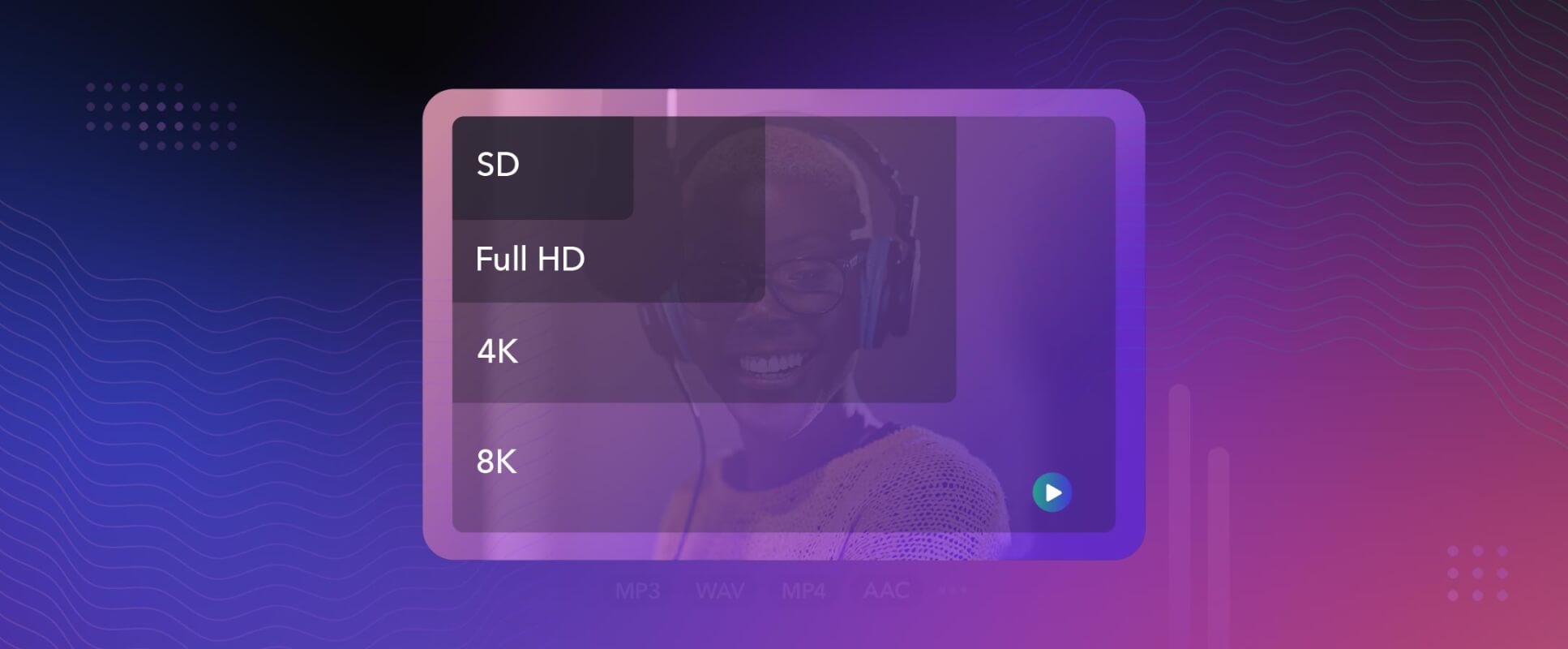When it comes to live streaming, optimizing your video output is crucial for enhancing the viewer experience for your audience. One way to do this is by ensuring your streaming settings use the optimal bitrate.
Determining the optimal bitrate settings for your specific streaming setup can be challenging because what works well for one broadcaster may not be ideal for another. On paper, a higher bitrate leads to higher-quality streams. However, this does not account for network conditions, bandwidth costs, and other factors.
We’ll cover what bitrate is, how it affects your stream, the best ways to improve it, and more. We will also discuss multi-bitrate streaming, a crucial technique for enhancing your user experience.
What is streaming bitrate?
Bitrate is the amount of data transferred within a specific timeframe and is commonly measured in bits per second (bps). This term can be referred to as “data rate” since it also measures the amount of information a system can handle during internet data transmission.
In streaming, it refers to the rate at which bits of a video file are processed and encoded within a given timeframe, where a bit represents the smallest unit of data.
Because videos contain a lot of information, bitrate can also be measured in megabits per second (MBps), as one megabit equals a million bits. However, this abbreviation shouldn’t be confused with Mbps (megabytes per second), as they mean different things. Kilobits per second is commonly used for audio files.

How does streaming bitrate affect video quality?
To understand how bitrate affects real-time streaming quality, it is essential to know how the streaming process works from a technical perspective.
When you press the “go live” button, your system will attempt to convert every frame of your broadcast into a digital format. Then, the data undergoes a process known as segmentation, where it’s encoded and transmitted to the content delivery network, and then distributed to viewers.
The higher your bitrate is, the greater volume of digital data is processed and transmitted from point A to point B, which ultimately affects the audio and video quality of your stream. Increasing your bitrate results in a better-quality stream that’s broadcast to the end-user.
However, your file size will also increase due to the amount of data being processed, which minimizes the available bandwidth of your system. The less bandwidth you have, the more likely you are to experience latency issues.
What factors impact streaming bitrate?
While bitrate is essential to ensuring a bufferless broadcast, it isn’t the only factor that matters in content creation. Numerous technical elements work behind the scenes when you go live and start your stream, and all of these need to be accounted for.
To determine the optimal bitrate for your stream, consider factors such as resolution, frame rate, upload speed, and storage limitations.
Frame rate
Frame rate, which is measured in frames per second (FPS), is the speed at which video frames are displayed. When streaming, you’re producing several consecutive frames, and your system has to convert each one into digital data for transmission.
A higher frame rate can result in a better quality stream.
Resolution
Resolution refers to the clarity of your footage and is measured in pixels per inch. To output a sharp broadcast, more pixels are needed.
Knowing the resolution can help you determine the appropriate bitrate for your stream. Typically, the highest resolution for streaming services like Facebook, YouTube, and Twitch is 1080p, followed by 720p, 480p, 360p, 240p, and 144p.
Upload speed
Your upload speed can help you determine how much bandwidth you have available, so you avoid reaching your limit. Bandwidth limits can significantly impact your streaming bitrate, even if it’s a high bps.
You can produce a high-quality video stream by ensuring you have enough bandwidth.
Storage and bandwidth limitations
Since your stream’s file size increases as your bitrate rises, you may run out of storage or bandwidth. You’ll need to ensure that you invest in sufficient video storage to meet your needs.
What is the optimal bitrate for streaming video?
As mentioned, a higher bitrate equals a larger file size. While some users may be able to enjoy a crisp, high-quality stream, other viewers may struggle to watch your stream if their internet connection isn’t equipped to handle such fast data transmission. Striking the right balance is vital for the viewer experience.
This is not a cut-and-dry answer, leaving many broadcasters with pressing questions. What are the best bitrate settings for streaming video, and what bitrate should you use for streaming?
While certain elements can affect the optimal bitrate for your stream, here are some recommendations:
- For full HD videos with 60fps and a resolution of 1080p, the ideal bitrate is between 4,500 and 6,000 kbps
- For full HD videos with 30fps and a resolution of 1080p, the ideal bitrate is between 3,500 and 5,000 kbps
- For HD videos with 60fps and a resolution of 720p, the ideal bitrate is between 3,500 and 5,000 kbps
- For HD videos with 30fps and a resolution of 720p, the ideal bitrate is between 2,500 and 4,000 kbps
In some cases, your broadcasting software can automatically optimize your settings according to the streaming platform you’re using and available resources. Double-check the settings created by this software to ensure they meet the requirements of your system and audience.
What is multi-bitrate (MBR) streaming?
There are so many variables in network conditions for both broadcasters and viewers, so making a stream available at multiple different bitrates is an excellent
Multi-bitrate streaming is a dynamic streaming technique that allows the stream to be available in multiple renditions. Adaptive bitrate (ABR) streaming, a similar concept that employs an MBR approach, automatically serves each video player a stream with the most suitable bitrate to yield the best experience for each viewer’s specific needs.
Adaptive bitrate streaming is influenced by network conditions, device type, and other determining factors, allowing the player to receive the stream at the optimal bitrate for clear, buffer-free viewing. It’s made possible with the help of different protocols, such as WebRTC and HESP.

How to optimize bitrate for streaming
Whether you’re streaming live events on your website or to your social media platforms, knowing how to optimize your bitrate is vital. You can do this by ensuring that other aspects of your setup are suitable for your chosen streaming bitrate.
Here are some tips to help optimize your bitrate to produce a higher-quality viewing experience for your audience.
Check your internet speed
The first way to ensure you’re choosing the right streaming bitrate is to verify that you have a sufficient upload speed to handle the bitrate you’re aiming to stream with.
You can determine your upload speed by conducting an internet speed test using a web-based tool. For example, you can use Speedtest by Ookla or simply Google “internet speed check” for an in-browser tool.
Use an Ethernet cable instead of Wi-Fi
The stability of your internet connection also affects the quality of your stream.
An Ethernet cable provides a direct line between your router and device, offering a more reliable and stronger connection. On the other hand, Wi-Fi is often unstable and unreliable, with frequent interruptions to data transmission.
Ultimately, the signal may be weaker during your stream when using a wireless connection, so a tethered connection can provide optimal results.
Avoid a bottleneck connection
A network bottleneck occurs when data flow is interrupted or blocked due to bandwidth limitations. It’s a good idea to close any non-essential apps to prevent exceeding your bandwidth during the live stream. It’s also best to check if malware or ads are running as you stream.
Additionally, avoid using other devices on the same network to maximize your internet speed. Instead, consider using a dedicated internet connection that’s only used for your stream.
Update your hardware and software
Updating your hardware and software may prevent latency issues that negatively affect your bitrate. Not only do you want to ensure that your software (drivers, applications, and operating system) are up to date, but you should also verify that your hardware is functioning correctly.
Test your setup to identify where any updates or repairs are needed. Update software accordingly, and replace any damaged hardware, including your Ethernet cable and ports, to prevent packet loss.
Use cloud video solutions
Cloud-based video solutions allow you to leverage the cloud to manage and run your stream. By loading applications and data into the cloud, you can free up space on your system and increase the available bandwidth.
A cloud-based broadcasting application can also help you live stream on multiple platforms. Seamlessly deploying a multistreaming strategy is undoubtedly a plus.
FAQs
Ultimately, your bitrate depends on your upload speed, storage limitations, resolution, and framerate. Ensure you know what your system can handle to optimize your bitrate. Otherwise, you may encounter buffering, latency, and other issues.
Yes, a high bitrate is typically better for live streaming. However, it’s not the only technical element needed to produce a quality stream. You also need a high-speed, wired internet connection, top-quality streaming gear, and proper hardware and system settings.
If your stream is 60fps, a suitable bitrate will fall between 4,500 and 6,000 Kbps for a 1080p broadcast. If the stream is 30fps, the ideal bitrate is 3,500 to 5,000 Kbps. However, there are a few factors to consider when adjusting your bitrate.
Final thoughts
Before streaming, double-check your bitrate settings to ensure they are correct. Bitrate is crucial to the quality of your stream, and it can impact other important factors. Remember that while a high bitrate can improve the quality of your broadcast, striking a balance is essential in producing an optimal viewing experience.
The support of a streaming solution with adaptive bitrate streaming takes some pressure off the quest to choose the perfect bitrate. Dolby OptiView’s end-to-end streaming solutions offer a dynamic approach to streaming bitrate, enabling broadcasters to provide higher-quality experiences to a broader audience of viewers.
Contact us today to discover how our solution can enhance your viewer experiences with real-time streaming, cross-platform delivery, and more.









